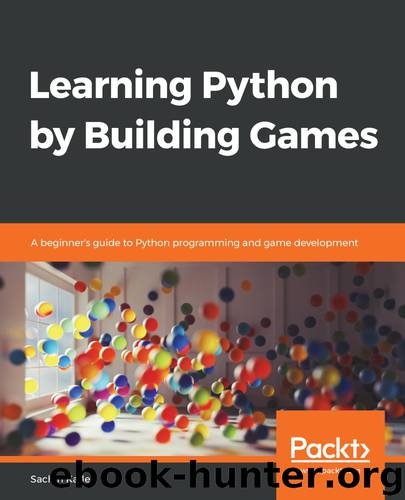Learning Python by Building Games by Sachin Kafle

Author:Sachin Kafle
Language: eng
Format: epub
Tags: COM012040 - COMPUTERS / Programming / Games, COM087020 - COMPUTERS / Desktop Applications / Design and Graphics, COM051360 - COMPUTERS / Programming Languages / Python
Publisher: Packt Publishing
Published: 2019-10-11T13:18:43+00:00
Dealing with two-dimensional vectors
Before actually exploring vectors, let's start with the basic overview of motion and how characters are moved in a straight line. To move any object or image, we have to make a slight change to the frames by a fixed amount. The movement must be fixed for each frame in order to make it symmetrical. To make an object move in a horizontal direction, we carry out an addition of a fixed amount to the x position, and to make it move in a vertical direction, we add the same amount to the y position. Thus, motion in 2D games can be represented as (x, y). Let's consider the following example to illustrate the usage of these coordinates on order to draw any shape into the game environment:
def line(a, b, x, y):
"Draw line from `(a, b)` to `(x, y)`."
import turtle
turtle.up()
turtle.goto(a, b)
turtle.down()
turtle.goto(x, y)
We are using the turtle module, which we used in the previous chapter to draw a line using the (a, b) and (x, y) positions. The goto() method is used to move the pen to the passed positions. These coordinates—(x, y) or (a, b)—clearly show the importance of knowing the positions in order to create game characters (we use line as a metaphor for any game character).
We can deem that the usage of a straight line motion is pretty useful, but looking at it from a different perspective, a game that only supports vertical or horizontal motions may seem dull and unexciting. For example, in the Pacman game, where a player would move either in a vertical or horizontal direction, this may be appropriate, but in the case of a car-racing game, where users can move in any direction, this motion doesn't work properly. We must be able to move in any direction by adjusting the positions of x and y for each frame. We will use the same two positions, x and y, to generate both straight and diagonal motions: a rate that indicates speed for the x and y positions. The form that represents (x, y) is known as a vector, but more importantly, vectors signify direction, unlike scalar. We will explore vectors in more detail in the following subsection.
Download
This site does not store any files on its server. We only index and link to content provided by other sites. Please contact the content providers to delete copyright contents if any and email us, we'll remove relevant links or contents immediately.
The Mikado Method by Ola Ellnestam Daniel Brolund(20724)
Hello! Python by Anthony Briggs(20010)
Secrets of the JavaScript Ninja by John Resig Bear Bibeault(18332)
Dependency Injection in .NET by Mark Seemann(18209)
The Well-Grounded Java Developer by Benjamin J. Evans Martijn Verburg(17688)
OCA Java SE 8 Programmer I Certification Guide by Mala Gupta(17496)
Kotlin in Action by Dmitry Jemerov(17308)
Adobe Camera Raw For Digital Photographers Only by Rob Sheppard(16937)
Algorithms of the Intelligent Web by Haralambos Marmanis;Dmitry Babenko(16319)
Grails in Action by Glen Smith Peter Ledbrook(15467)
Test-Driven iOS Development with Swift 4 by Dominik Hauser(10417)
Becoming a Dynamics 365 Finance and Supply Chain Solution Architect by Brent Dawson(8056)
Microservices with Go by Alexander Shuiskov(7820)
Practical Design Patterns for Java Developers by Miroslav Wengner(7724)
Test Automation Engineering Handbook by Manikandan Sambamurthy(7672)
Angular Projects - Third Edition by Aristeidis Bampakos(7160)
The Art of Crafting User Stories by The Art of Crafting User Stories(6611)
NetSuite for Consultants - Second Edition by Peter Ries(6534)
Demystifying Cryptography with OpenSSL 3.0 by Alexei Khlebnikov(6305)
